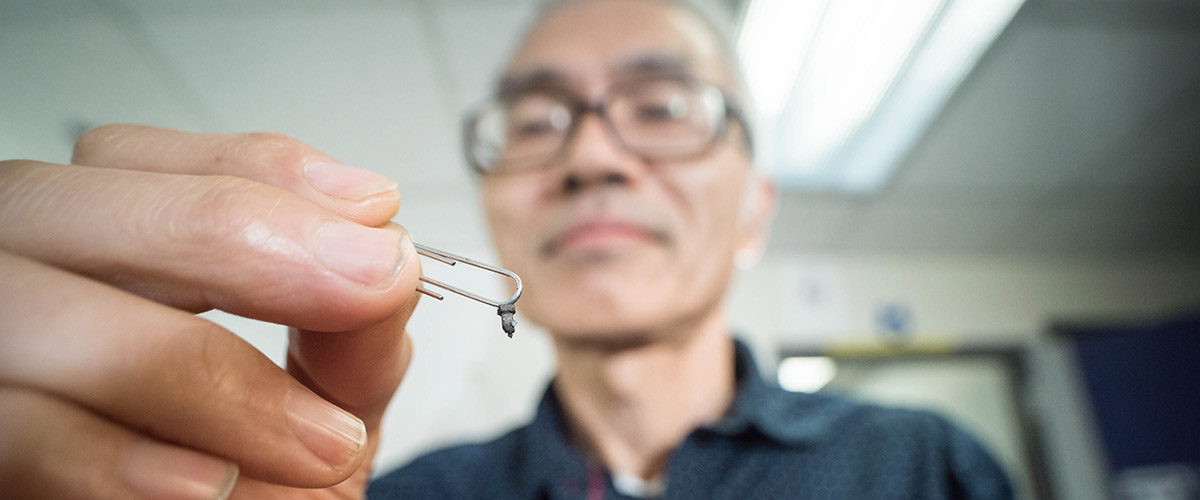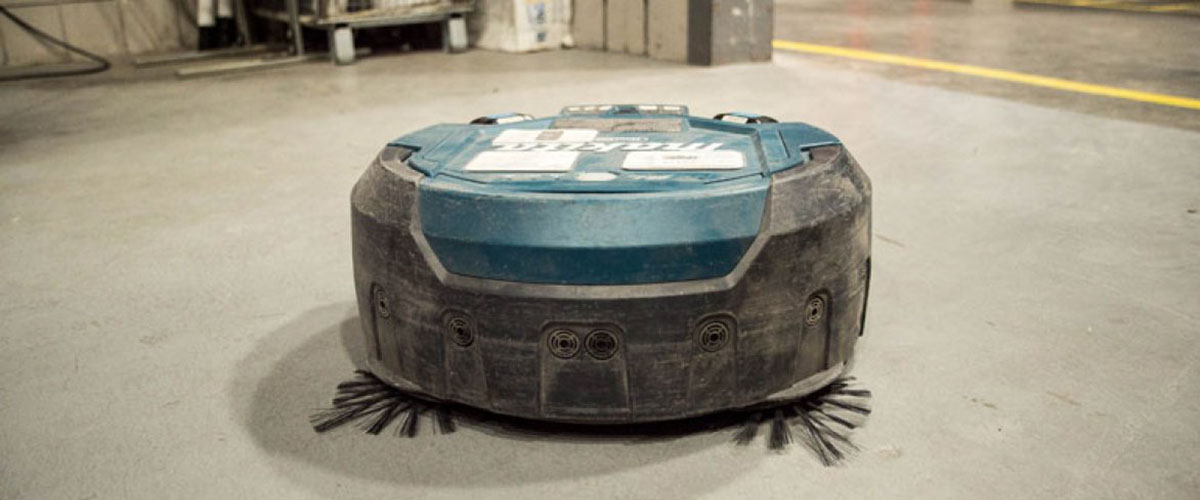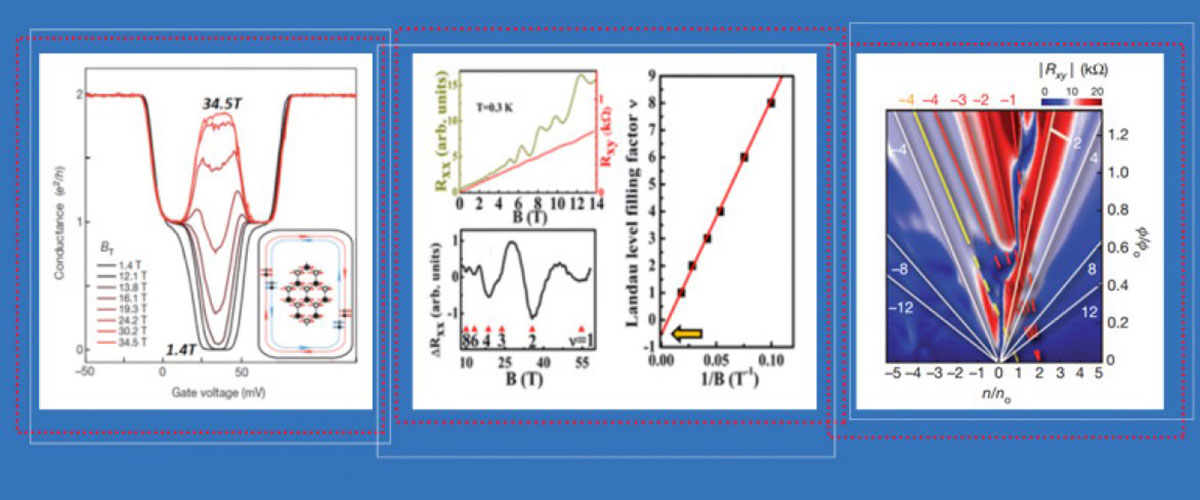Science has its principles, laws and theories. So does economics. This is a story about how one can beget the other, or how the law of supply and demand led to a research project that has brought a new kind of strong permanent magnet one step closer to market.
At the center of this story is the rare-earth element neodymium, mined primarily in China. It first became a household word in the 1980s, when a new magnet made from neodymium, iron and boron was invented. Packing a lot of power in little package, the new “neo” magnets took the automotive, robotics and electronics industries by storm.

Theo Siegrist
"That is what revolutionized motors," explained Theo Siegrist, a MagLab researcher and professor at the college of engineering run jointly by Florida A&M University and Florida State University in Tallahassee, Fla. He pointed to a small block of the stuff clinging tenaciously to the mini fridge in his cluttered office. The 20-mm-square cube boasted a magnetic field of about half a tesla, at least an order of magnitude stronger, ounce for ounce, than the flimsy barium iron oxide magnets beside it.
"Without this, you wouldn't have adjustable seats in your car, you wouldn't have easy, electrical window lifters, we wouldn't have windmills for wind power," Siegrist continued. "You wouldn't have any of these very small motors with high torques."
But the dream material eventually led to a nightmare: In 2010 its relative scarcity, combined with other economic, geopolitical and environmental factors, caused a Matterhorn-like price spike. By then neo magnets were deeply engrained in our lives, found in everything from ear buds to jewelry clasps, from cell phones to power cords. The price hike had a lot of companies worried.
Within a few months the dust had settled, and prices came back down to earth (although they remained higher than before the spike). But not before a group of researchers at the Tallahassee-based National High Magnetic Field Laboratory, prodded by a local magnet-dependent industry, decided to look for a neo alternative.
Today, their findings are attracting renewed interest: The mighty swing of the price pendulum has swept the price of neodymium up yet again. Since the beginning of 2017, it has skyrocketed more than 80 percent.
Magnetic Challenge
The National MagLab is a user facility boasting many of the world’s most powerful and unique electromagnets; scientists from around the world travel there to use the massive instruments to probe everything from proteins to semiconductors to the human body, observing what goes on at the atomic level./
Across the street from the lab sits a manufacturer of energy-efficient compressors that has something in common with the MagLab: They also rely on magnets. But theirs (unlike the electromagnetic behemoths of the MagLab) are small neo magnets that help make their compressors work. Back in 2010, after the first spike of neodymium prices, company leaders were concerned enough to ask their neighbor to research alternatives.
"They figured we have high-field magnets," said Ke Han, a materials scientist at the lab, "so we should know something about this."
It was a tall order: Neo magnets have a lot going for them. For one thing, iron is cheap and readily available. More importantly, being ferromagnetic, it has a lot of "magnetic moment" — which means its electrons spin in a way that predisposes them to align with an external magnetic field, an essential property for good magnet fodder.
But just as bread can’t rise without yeast, iron needs an active ingredient to make it a good magnet, and neodymium fits the bill. It adds a critical and complementary property to the recipe called anisotropy.
"In order to make a magnet, you need lots of magnetic moment: That's what the iron is for," explained Siegrist. "But in regular iron the spins don’t want to all point in one direction easily. So that's why you add the neodymium, because that gives you what's called magnetocrystalline anisotropy. That pins the spins all in one direction."
The powerful pairing of neodymium and iron is tough to beat.
Still, Han, collaborating with Siegrist and their respective teams, took on the task. Decades earlier, scientists were driven to invent neo magnets as a response to the rising price of samarium cobalt, at that time the go-to option for a little strong magnet. Perhaps now the MagLab group could unseat neo as reigning magnet champion — or at least offer the world a viable alternative.
The scientists felt confident they could break new ground in understanding magnetic systems. But even the act of pursing the problem would catch people’s attention, MagLab Director Greg Boebinger told them.
"Even if you don't produce anything, people will know that you are doing something," Boebinger said. "That will definitely have some impact."

A sample of manganese gallium.
The research team decided to focus on manganese gallium (MnGa), a promising magnetic system. Although much studied, no one had ever used high-field magnets to better understand its potential for permanent magnets.
On paper, the pairing was promising. Not quite as cheap and abundant as iron, manganese is still readily available. And when combined with gallium, it makes a permanent magnet. A convenient byproduct of the aluminum industry, gallium also has the advantage of a low melting point, which would make MnGa magnets cheaper to produce.
But there was still something keeping MnGa from threatening neo’s dominance: It lacked high remanence, or the ability to retain its magnetic field. Along with coercivity (a measure of a material's ability to resist demagnetization), high remanence is a prerequisite for a really good magnet.
Han and Siegrist suspected they could do something about that.
High-field Twist
Once the scientists had their two ingredients, it was a time to experiment. Daniel Brown, Han's graduate student at the time, did the bulk of the work, tirelessly tweaking the recipe to find out what ratios and techniques would maximize the material's magnetic potential.
The first step in this metallurgical process was to mix the ingredients by grinding. Getting that chemistry exactly right took some time. "We did have a lot of trial and error getting the proportions correct," said Han.
The mixture then needed to bake: High heat brings about new phases of the material that unlock its magnetic properties. Researchers played with time and temperature — up to 360 degrees Celsius — to pinpoint the optimal conditions for this annealing process. It needed to be toasty, but not too toasty: Every magnetic material has a “Curie temperature,” above which its magnetism fades.
All great chefs bring a special je ne sais quoi to their recipes, and Han and Siegrist were no exception. Their special twist: a high magnetic field. The team heated the MnGa inside a tiny oven that was itself placed inside a high-field electromagnet, a special process dubbed magnetic field annealing (MFA). They heated the samples inside a field of 31 teslas for up to two hours, and compared those results to annealing with no magnetic field.
Exposure to a magnetic field is part of making any permanent magnet: That's what induces most of the crystals and spins in the material to align with the applied field, fixing them in place and accounting for the "permanent" in "permanent magnet." But the MFA process used by the MagLab scientists, featuring a field 30 times stronger than would typically be used in magnet production, accomplished even more: It significantly boosted MnGa’s remanence, accompanied by high coercivity.
"The high coercivity is definitely a very good plus," said Han. "It means the magnet can be inside a large magnetic field and still retain its magnetic properties: It will continue to work."
In addition, the MFA process increased the material's magnetic moment by 50 percent, suggesting a lot of untapped potential in the system. "That means we still have room to make improvements in the material," Han said. "That's another thing we are very excited about."
Does all this mean MnGa has bumped neo off its pedestal?
Hardly. Neo is still the champ. But it may need to start looking over its shoulder.
"We showed that this material is worth pursuing," said Siegrist. "Between manganese, which is relatively cheap, and gallium, which allows you to have reasonably low-temperature processing, together you could do all sorts of things."
MnGa doesn't need to outperform neo, ounce per ounce, to be valuable: It may just need to find its niche. Samarium-cobalt magnets, for example, aren't quite as strong as neo and cost more to make. But because of their high Curie temperature, they are used in applications requiring high performance at high temperature, which neo can’t deliver. MnGa may have also have a special talent that is not yet fully understood, such as its ability to work within high magnetic fields.
"What we have now is another arrow in the quiver of solutions," said Siegrist. "So if, for a particular application, neodymium iron and samarium cobalt do not do the job, then we may consider something like this. There might be a problem out there where this is the ticket."
In addition to Han, Siegrist and Brown, the following MagLab staff contributed to this research: Jun Lu, Yan Xin, Tiglet Besara (now at Missouri State University) and Rongmei Niu.
For more details on this research, read the Science Highlight or the full-length publication, High Magnetic Field Annealing of Mn-Ga Intermetallic Alloys, in MRS Advances.
Reprinted with permission from R&D magazine under the title Moving Past Neodymium: Scientists Explore Alternative to Expensive Rare Earth Element.
By Kristen Coyne






